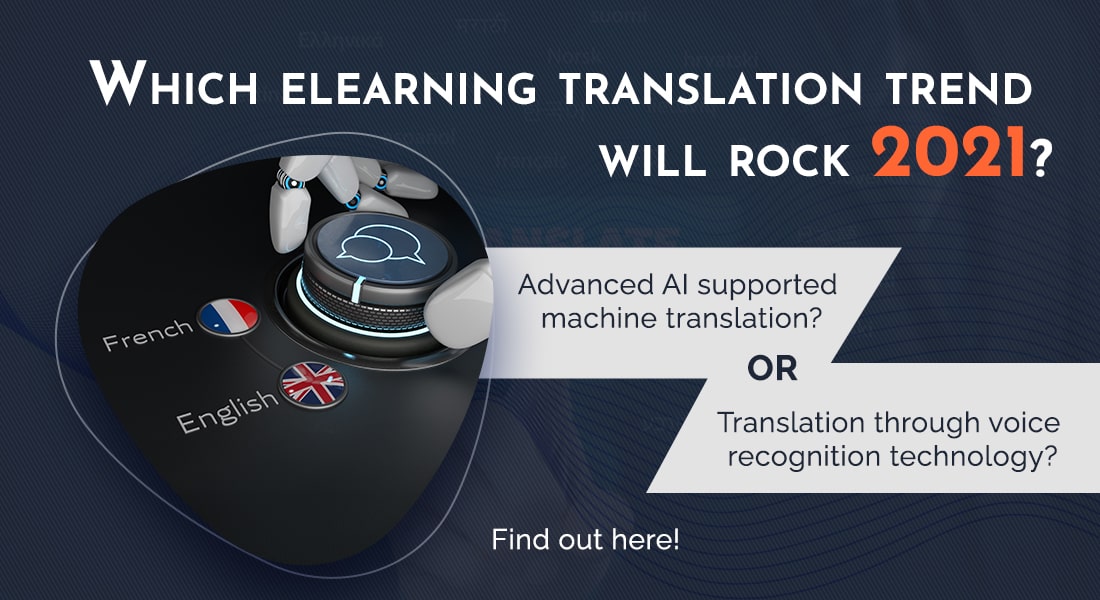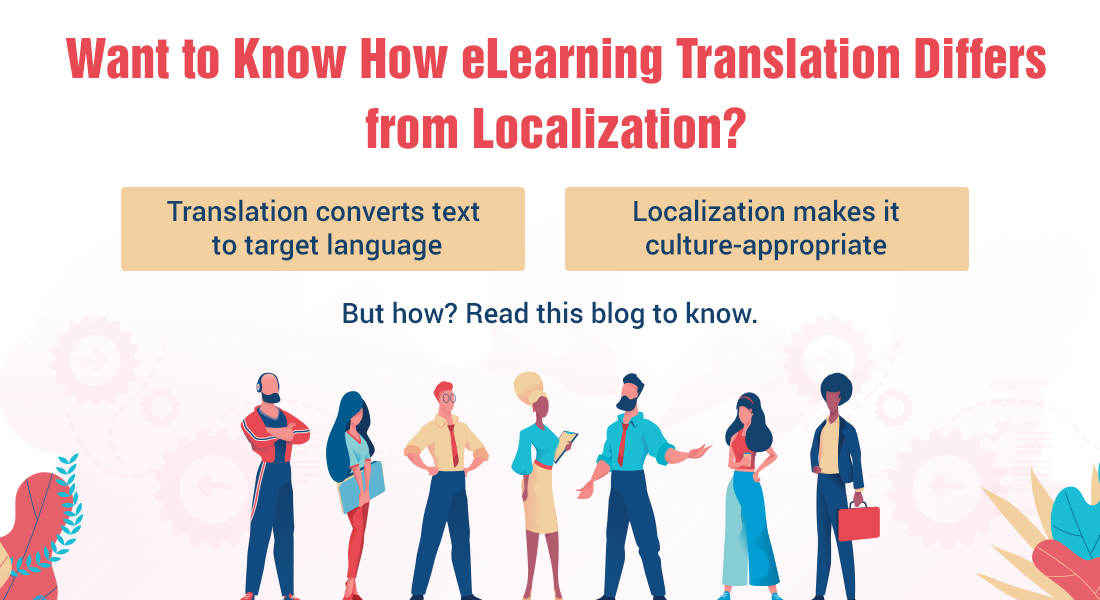Five Translation and Localization Trends of 2021 You Shouldn’t Miss

Why is eLearning translation and localization important? Global corporations with a widely dispersed workforce often find it difficult to train their employees from diverse linguistic and cultural backgrounds.
Top 5 Translation Trends for 2021
- Context considerations for more efficient translation
- Use of memory tools and mobile accessibility for translators
- Localization of all aspects of courses
- Translation and localization of audio-visual elements and in-media captions
- Translation through voice recognition
Learning anything becomes so much easier when it is done in one’s own language. Often a single eLearning course needs to be translated into more than 10 or 20 languages to ensure consistent effective training across the organization. E-learning vendors and professional translators have been taking care of eLearning translation and localization for years. But there are some advancements in accessible technologies that can improve translation a great deal.
In this blog, I have narrowed down the top 5 hottest trends in translation, which I believe can help improve eLearning translation.
Find out the real eLearning trends for 2021 through this webinar. Click here NOW!
Top 5 Potential Trends for E-learning Translations in 2021
Check out the five trends that I believe will significantly improve eLearning translation now and in the foreseeable future.
1. Context-Responsive Machine Translation
Perhaps the biggest translation challenge in recent times that has now become a trend is the enhancement of context-aware machine translation programs. Most machine translations do a verbatim translation of the text without considering its context – what is written before and after that – which results in the translation not being semantically appropriate. Remember how Google Translate often produces funny sentences which even though are correct in a literal sense, do not capture the essence and actual meaning of the source text.
When you provide a sentence for translation, the algorithm translates the sentence word for word, with the onus of getting the meaning on the reader. Such translation barriers could be overcome through human translators who translate the source text into target language, and correlate it with the overall textual context from the lines before and after that, resulting in a near perfect translation.
Neural Machine Translation (NMT) using deep learning and artificial neural networks is adopting a top-down translation approach, where the algorithm study the entire text (and not just the target sentence), to actually understand the context of the text for a much better and more accurate translation experience. This is very useful when translating eLearning courses for corporate training, as complicated pieces of text can be translated faster and more accurately.
2. Memory Tools and Mobile Accessibility for Easier and Faster Translation
No one likes to repeat the same stuff they have been doing for days/months/years. The same holds true for translators too who find translating the same word over and over again for different parts of the course cumbersome and a sheer waste of time. Translation Memory Tools (TMT) are part of the CAT (Computer Assisted Translation) tools that aid translation by memorizing and storing all the words, phrases, and common sentences that have been translated.
Once a word or phrase is translated and saved in the database, it will be automatically pulled if needed during subsequent translations. What’s more, cloud storage allows multiple translators to access the repository if they are working collaboratively on multiple devices. So, even translating courses for mobile learning becomes way easier thanks to TMTs being accessible on mobile devices.
Translating off-the-shelf compliance courses into multiple languages can be greatly simplified with TMTs. Even if such courses need new updates every year, most words and phrases remain the same, and therefore, using pre-translated phrases and words makes perfect sense.
3. More Culturally Localized Courses
Cultural influence on instructional design also needs to be given due consideration given courses designed for learners of a specific culture are not a good fit for learners of a different culture. This makes localization as important as translation, and the eLearning industry has now started curating culturally sensitive and responsive courses from the main source courses. This is done either by modifying the visuals and graphics, narratives, audio, and video elements, etc. to fit the target culture, or by keeping them culturally neutral in the first place to avoid complications.
It is true that localization is not exactly a new concept. However, the impact of the ongoing COVID-19 crisis on training has shown that employees can be relied upon to work and learn from their homes without going to their workplaces. In such cases, translating and localizing eLearning courses for specific cultures become more necessary to ensure learners in foreign locations do not feel isolated because of a simple language or cultural barrier.
Sales, product, performance support, and compliance training are some of the examples of courses that must be localized so that the learner receives real-time and real-life knowledge on the culturally curated topic.
4. Audio-Visual Translation and Localization
The first thing that comes to mind about ‘translation’ is probably a series of English texts converted to some foreign language. But translation and localization in 2021 will see an increased focus on translation of audio-visual elements as well. Confused? Don’t be.
It just means that even the media elements in the course will be curated according to learners’ geographical, linguistic, and cultural background – apart from the text, the narrations in videos and audios, as well as the subtitles and captions (if any) will also be translated to the target language. What’s more, any images and graphics if included, will also be localized for the target audience so that they do not feel alienated by a course having elements they do not understand.
5. Voice Recognition Translation Access
Voice recognition is another modern-day trend in translation that is reducing workloads significantly. Although it might seem like something highly advanced, in reality, the pipeline for this technology has existed for many years in the form of speech-to-text and text-to-speech engines. So, as you speak to your Google assistant, or go, ‘Hey Siri’, the device is actually translating your English speech to binary information so that the device can understand your command.
Translation with voice recognition takes that a step further by listening to your speech, translating it into the target language, and presenting you with the output (which you can choose to play as automated audio narration). Translation vendors nowadays use voice recognition software to ease the translation process. This technology reduces translation effort and time, and can be particularly helpful in training sales executives in foreign countries where they can play a sample sales presentation audio (or video) and understand what they need to say.
Wrapping Up!
Are these groundbreaking trends? No, not at all. Technology is slowly reaching a saturation point. So until the day an algorithm can replicate the human brain completely, I doubt any innovation will be groundbreaking enough.
Regardless, there is a lot of potential for translation in corporate training. Be it translating long eLearning courses or small microlearning modules for corporate training, translation ensures that two different learners from two different locations receive the same information, to reach the same level of competency. These translation and localization trends may not turn a lot of heads, but can be quite significant for the right people, Are you one of them?
Wondering about the role of culture in corporate training? You can have your queries answered in this scientifically backed whitepaper on the realities of cross-cultural eLearning. Download it now.





